Sustainable Land Use Diagnosis Based on the Perspective of Coupling Socioeconomy and Ecology in the Xiongan New Area, China
Abstract
1. Introduction
2. Construction of an LUS Index System Based on Social-Ecological Systems Theory and SDGs
2.1. Theoretical Framework
2.2. Construction of Indicator System
3. Materials and Methods
3.1. Study Area
3.2. Data Sources
3.3. Methods
3.3.1. Calculation of Indicators of LUS
- (1)
- Soil conservation model
- (2)
- Water Production Model
- (3)
- Net ecosystem productivity (NEP) estimation methods
3.3.2. Global Entropy Method
3.3.3. Coupling Coordination Degree Model
3.3.4. Geographical Detectors
4. Results
4.1. Spatial-Temporal Pattern of Sustainable Land Use Subsystems at the Township Level
4.2. Coupling Coordination between Sustainable Land Use Subsystems at the Township Level
4.2.1. Spatial and Temporal Coupling Coordination Degree of Sustainable Land Use Subsystems at the Township Level
4.2.2. Relative Sustainability Performance of Land Use Subsystems at the Township Level
4.3. Impact Factors of CCD between Sustainable Land Use Subsystems
4.4. Development Patterns of Towns in Xiongan’s New Area
5. Discussion
5.1. Insight into the Sustainability Level, Coupling Coordination Degree, and Driving Mechanisms of Land Use Subsystems
5.2. Policy Implications for Sustainable Development
5.3. Limitations and Prospects for Future Research
6. Conclusions
Author Contributions
Funding
Data Availability Statement
Acknowledgments
Conflicts of Interest
References
- Liu, J.; Jin, X.; Xu, W.; Gu, Z.; Yang, X.; Ren, J.; Fan, Y.; Zhou, Y. A New Framework of Land Use Efficiency for the Coordination among Food, Economy and Ecology in Regional Development. Sci. Total Environ. 2020, 710, 135670. [Google Scholar] [CrossRef] [PubMed]
- Seto, K.C.; Golden, J.S.; Alberti, M.; Turner, B.L. Sustainability in an Urbanizing Planet. Proc. Natl. Acad. Sci. USA 2017, 114, 8935–8938. [Google Scholar] [CrossRef] [PubMed]
- van Vliet, J. Direct and Indirect Loss of Natural Area from Urban Expansion. Nat. Sustain. 2019, 2, 755–763. [Google Scholar] [CrossRef]
- Torre, A.; Melot, R.; Magsi, H.; Bossuet, L.; Cadoret, A.; Caron, A.; Darly, S.; Jeanneaux, P.; Kirat, T.; Pham, H.V.; et al. Identifying and measuring land-use and proximity conflicts: Methods and identification. SpringerPlus 2014, 3, 1–26. [Google Scholar] [CrossRef] [PubMed]
- Chen, S.S.; Kimirei, I.A.; Yu, C.; Shen, Q.; Gao, Q. Assessment of urban river water pollution with urbanization in East Africa. Environ. Sci. Pollut. Res. 2022, 29, 40812–40825. [Google Scholar] [CrossRef] [PubMed]
- Zhang, J.; Pu, L.; Peng, B.; Gao, Z. The impact of urban land expansion on soil quality in rapidly urbanizing regions in China: Kunshan as a case study. Environ. Geochem. Health 2011, 33, 125–135. [Google Scholar] [CrossRef]
- Wang, X. Managing Land Carrying Capacity: Key to Achieving Sustainable Production Systems for Food Security. Land 2022, 11, 484. [Google Scholar] [CrossRef]
- Zhang, Z.; Liu, F.; Zhao, X.; Wang, X.; Shi, L.; Xu, J.; Yu, S.; Wen, Q.; Zuo, L.; Yi, L.; et al. Urban Expansion in China Based on Remote Sensing Technology: A Review. Chin. Geogr. Sci. 2018, 28, 727–743. [Google Scholar] [CrossRef]
- Salvati, L.; Karamesouti, M.; Kosmas, K. Soil degradation in environmentally sensitive areas driven by urbanization: An example from Southeast Europe. Soil Use Manag. 2014, 30, 382–393. [Google Scholar] [CrossRef]
- Fan, Y.; Fang, C.; Zhang, Q. Coupling coordinated development between social economy and ecological environment in Chinese provincial capital cities-assessment and policy implications. J. Clean. Prod. 2019, 229, 289–298. [Google Scholar] [CrossRef]
- Yang, W. Ecological Civilization Is a New State of Civilization Featuring the Harmony between Man and Nature. Chin. J. Urban Environ. Stud. 2020, 8, 128–130. [Google Scholar] [CrossRef]
- Zhou, M. An Interval Fuzzy Chance-Constrained Programming Model for Sustainable Urban Land-Use Planning and Land Use Policy Analysis. Land Use Policy 2015, 42, 479–491. [Google Scholar] [CrossRef]
- Domingo, D.; Palka, G.; Hersperger, A.M. Effect of zoning plans on urban land-use change: A multi-scenario simulation for supporting sustainable urban growth. Sustain. Cities Soc. 2021, 69, 102833. [Google Scholar] [CrossRef]
- Koroso, N.H.; Zevenbergen, J.A.; Lengoiboni, M. Urban land use efficiency in Ethiopia: An assessment of urban land use sustainability in Addis Ababa. Land Use Policy 2020, 99, 105081. [Google Scholar] [CrossRef]
- Lu, X.-H.; Ke, S.-G. Evaluating the effectiveness of sustainable urban land use in China from the perspective of sustainable urbanization. Habitat Int. 2018, 77, 90–98. [Google Scholar] [CrossRef]
- Turner, B.L., II; Kasperson, R.E.; Matson, P.A.; McCarthy, J.J.; Corell, R.W.; Christensen, L.; Eckley, N.; Kasperson, J.X.; Luers, A.; Martello, M.L.; et al. A framework for vulnerability analysis in sustainability science. Proc. Natl. Acad. Sci. USA 2003, 100, 8074–8079. [Google Scholar] [CrossRef]
- Ostrom, E. A General Framework for Analyzing Sustainability of Social-Ecological Systems. Science 2009, 325, 419–422. [Google Scholar] [CrossRef]
- Kuhlman, T.; Farrington, J. What Is Sustainability? Sustainability 2010, 2, 3436–3448. [Google Scholar] [CrossRef]
- Moore, J.E.; Mascarenhas, A.; Bain, J.; Straus, S.E. Developing a comprehensive definition of sustainability. Implement. Sci. 2017, 12, 110. [Google Scholar] [CrossRef]
- Ramsey, J.L. On Not Defining Sustainability. J. Agric. Environ. Ethics 2015, 28, 1075–1087. [Google Scholar] [CrossRef]
- Winston, N. Sustainable community development: Integrating social and environmental sustainability for sustainable housing and communities. Sustain. Dev. 2021, 30, 191–202. [Google Scholar] [CrossRef]
- Fu, B.; Chen, L.; Ma, C. The Index System and Method of Land Sustainable Use Evaluation. J. Nat. Resour. 1997, 12, 113–118. [Google Scholar]
- Fu, J.; Bu, Z.; Jiang, D.; Lin, G.; Li, X. Sustainable land use diagnosis based on the perspective of production–living–ecological spaces in China. Land Use Policy 2022, 122, 106386. [Google Scholar] [CrossRef]
- Lu, X.; Zhang, Y.; Lin, C.; Wu, F. Analysis and comprehensive evaluation of sustainable land use in China: Based on sustainable development goals framework. J. Clean. Prod. 2021, 310, 127205. [Google Scholar] [CrossRef]
- Liang, J.; Li, Y. Resilience and Sustainable Development Goals Based Social-Ecological Indicators and Assessment of Coastal Urban Areas—A Case Study of Dapeng New District, Shenzhen, China. Watershed Ecol. Environ. 2020, 2, 6–15. [Google Scholar] [CrossRef]
- Nziguheba, G.; Adewopo, J.; Masso, C.; Nabahungu, N.L.; Six, J.; Sseguya, H.; Taulya, G.; Vanlauwe, B. Assessment of sustainable land use: Linking land management practices to sustainable land use indicators. Int. J. Agric. Sustain. 2022, 20, 265–288. [Google Scholar] [CrossRef]
- Wang, P.; Qi, M.; Liang, Y.; Ling, X.; Song, Y. Examining the Relationship between Environmentally Friendly Land Use and Rural Revitalization Using a Coupling Analysis: A Case Study of Hainan Province, China. Sustainability 2019, 11, 6266. [Google Scholar] [CrossRef]
- Giri, S.; Qiu, Z. Understanding the relationship of land uses and water quality in Twenty First Century: A review. J. Environ. Manag. 2016, 173, 41–48. [Google Scholar] [CrossRef]
- Tran, D.X.; Pla, F.; Latorre-Carmona, P.; Myint, S.W.; Caetano, M.; Kieu, H.V. Characterizing the relationship between land use land cover change and land surface temperature. ISPRS J. Photogramm. Remote Sens. 2017, 124, 119–132. [Google Scholar] [CrossRef]
- Liang, L.; Zhang, F.; Wu, F.; Chen, Y.X.; Qin, K.Y. Coupling coordination degree spatial analysis and driving factor between socio-economic and eco-environment in northern China. Ecol. Indic. 2022, 135, 108555. [Google Scholar] [CrossRef]
- Zhang, D.; Chen, Y. Evaluation on urban environmental sustainability and coupling coordination among its dimensions: A case study of Shandong Province, China. Sustain. Cities Soc. 2021, 75, 103351. [Google Scholar] [CrossRef]
- Cheng, H.; Zhu, L.; Meng, J. Fuzzy evaluation of the ecological security of land resources in mainland China based on the Pressure-State-Response framework. Sci. Total Environ. 2022, 804, 150053. [Google Scholar] [CrossRef]
- Xiao, R.; Lin, M.; Fei, X.; Li, Y.; Zhang, Z.; Meng, Q. Exploring the Interactive Coercing Relationship between Urbanization and Ecosystem Service Value in the Shanghai–Hangzhou Bay Metropolitan Region. J. Clean. Prod. 2020, 253, 119803. [Google Scholar] [CrossRef]
- Tong, D.; Sun, Y.; Tang, J.; Luo, Z.; Lu, J.; Liu, X. Modeling the interaction of internal and external systems of rural settlements: The case of Guangdong, China. Land Use Policy 2023, 132, 106830. [Google Scholar] [CrossRef]
- Li, T.; Li, D.; Liang, D.; Huang, S. Coupling Coordination Degree of Ecological-Economic and Its Influencing Factors in the Counties of Yangtze River Economic Belt. Sustainability 2022, 14, 15467. [Google Scholar] [CrossRef]
- Xie, X.; Fang, B.; Xu, H.; He, S.; Li, X. Study on the coordinated relationship between Urban Land use efficiency and ecosystem health in China. Land Use Policy 2021, 102, 105235. [Google Scholar] [CrossRef]
- Yin, G.; Liu, Y.; Wang, F. Emerging Chinese new towns: Local government-directed capital switching in inland China. Cities 2018, 79, 102–112. [Google Scholar] [CrossRef]
- Long, H.; Liu, Y.; Hou, X.; Li, T.; Li, Y. Effects of land use transitions due to rapid urbanization on ecosystem services: Implications for urban planning in the new developing area of China. Habitat Int. 2014, 44, 536–544. [Google Scholar] [CrossRef]
- Liu, L.; Jiang, K.; Hu, Z.; Feng, H. Response Characteristics of Ecosystem Services Values in Territorial Space Development of Xiong’an New Area. Acta Ecol. Sin. 2022, 42, 2098–2111. [Google Scholar]
- Liu, Z.; de Jong, M.; Li, F.; Brand, N.; Hertogh, M.; Dong, L. Towards Developing a New Model for Inclusive Cities in China—The Case of Xiong’an New Area. Sustainability 2020, 12, 6195. [Google Scholar] [CrossRef]
- Xue, C.Q.; Wang, Y.; Tsai, L. Building new towns in China—A case study of Zhengdong New District. Cities 2013, 30, 223–232. [Google Scholar] [CrossRef]
- Huo, J.; Shi, Z.; Zhu, W.; Xue, H.; Chen, X. A Multi-Scenario Simulation and Optimization of Land Use with a Markov–FLUS Coupling Model: A Case Study in Xiong’an New Area, China. Sustainability 2022, 14, 2425. [Google Scholar] [CrossRef]
- Yang, J.; Li, Y.; Hay, I.; Huang, X. Decoding national new area development in China: Toward new land development and politics. Cities 2019, 87, 114–120. [Google Scholar] [CrossRef]
- Levin, S.; Xepapadeas, T.; Crépin, A.-S.; Norberg, J.; de Zeeuw, A.; Folke, C.; Hughes, T.; Arrow, K.; Barrett, S.; Daily, G.; et al. Social-ecological systems as complex adaptive systems: Modeling and policy implications. Environ. Dev. Econ. 2013, 18, 111–132. [Google Scholar] [CrossRef]
- Liu, J.; Dietz, T.; Carpenter, S.R.; Alberti, M.; Folke, C.; Moran, E.; Pell, A.N.; Deadman, P.; Kratz, T.; Lubchenco, J.; et al. Complexity of Coupled Human and Natural Systems. Science 2007, 317, 1513–1516. [Google Scholar] [CrossRef]
- Ostrom, E. A Diagnostic Approach for Going Beyond Panaceas. Proc. Natl. Acad. Sci. USA 2007, 104, 15181–15187. [Google Scholar] [CrossRef]
- Cinner, J.E.; Barnes, M.L. Social Dimensions of Resilience in Social-Ecological Systems. One Earth 2019, 1, 51–56. [Google Scholar] [CrossRef]
- de Groot, R. Function-Analysis and Valuation as a Tool to Assess Land Use Conflicts in Planning for Sustainable, Multi-Functional Landscapes. Landsc. Urban Plan. 2006, 75, 175–186. [Google Scholar] [CrossRef]
- Han, D.; Yu, D.; Qiu, J. Assessing coupling interactions in a safe and just operating space for regional sustainability. Nat. Commun. 2023, 14, 1369. [Google Scholar] [CrossRef]
- Bryan, B.A.; Nolan, M.; McKellar, L.; Connor, J.D.; Newth, D.; Harwood, T.; King, D.; Navarro, J.; Cai, Y.; Gao, L.; et al. Land-use and sustainability under intersecting global change and domestic policy scenarios: Trajectories for Australia to 2050. Environ. Chang. 2016, 38, 130–152. [Google Scholar] [CrossRef]
- Song, Y.; Yeung, G.; Zhu, D.L.; Xu, Y.; Zhang, L.X. Efficiency of Urban Land Use in China’s Resource-Based Cities, 2000-2018. Land Use Policy 2022, 115, 106009. [Google Scholar] [CrossRef]
- Xue, D.; Yue, L.; Ahmad, F.; Draz, M.U.; Chandio, A.A.; Ahmad, M.; Amin, W. Empirical investigation of urban land use efficiency and influencing factors of the Yellow River basin Chinese cities. Land Use Policy 2022, 117, 106117. [Google Scholar] [CrossRef]
- Ruan, F. The Driving Role of Food and Cultivated Land Resource in Balancing the Complex Urban System of Socio-Economy and Environment: A Case Study of Shanghai City in China. Land 2023, 12, 905. [Google Scholar] [CrossRef]
- Li, Y.; Cao, Z.; Long, H.; Liu, Y.; Li, W. Dynamic analysis of ecological environment combined with land cover and NDVI changes and implications for sustainable urban–rural development: The case of Mu Us Sandy Land, China. J. Clean. Prod. 2017, 142, 697–715. [Google Scholar] [CrossRef]
- Sun, B.; Zhao, H.; Lu, F.; Wang, X. Spatial and Temporal Patterns of Carbon Sequestration in the Northeastern Forest Regions and Its Impact Factors Analysis. Acta Ecol. Sin. 2018, 38, 4975–4983. [Google Scholar]
- Li, M.Y.; Liang, D.; Xia, J.; Song, J.X.; Cheng, D.D.; Wu, J.T.; Cao, Y.L.; Sun, H.T.; Li, Q. Evaluation of Water Conservation Function of Danjiang River Basin in Qinling Mountains, China Based on Invest Model. J. Environ. Manag. 2021, 286, 112212. [Google Scholar] [CrossRef]
- Lü, Y.; Fu, B.; Feng, X.; Zeng, Y.; Liu, Y.; Chang, R.; Sun, G.; Wu, B. A Policy-Driven Large Scale Ecological Restoration: Quantifying Ecosystem Services Changes in the Loess Plateau of China. PLoS ONE 2012, 7, e31782. [Google Scholar] [CrossRef]
- Xu, B. China’s National New Areas in the ecological transition. Environ. Dev. Sustain. 2023, 25, 3747–3770. [Google Scholar] [CrossRef]
- Hou, C.; Han, Y.; Meng, X.; Liu, L. Effects of Land-Use Change on Ecosystem Service Values in Xiong’an New Area from 1995 to 2019. J. Environ. Eng. Technol. 2021, 11, 65–73. [Google Scholar]
- Wang, C.; Zhan, J.; Zhang, F.; Liu, W.; Twumasi-Ankrah, M.J. Analysis of urban carbon balance based on land use dynamics in the Beijing-Tianjin-Hebei region, China. J. Clean. Prod. 2021, 281, 125138. [Google Scholar] [CrossRef]
- Guo, W.; Teng, Y.; Yan, Y.; Zhao, C.; Zhang, W.; Ji, X. Simulation of Land Use and Carbon Storage Evolution in Multi-Scenario: A Case Study in Beijing-Tianjin-Hebei Urban Agglomeration, China. Sustainability 2022, 14, 13436. [Google Scholar] [CrossRef]
- Luo, X.; Tong, X.; Pan, H. Integrating Multiresolution and Multitemporal Sentinel-2 Imagery for Land-Cover Mapping in the Xiongan New Area, China. IEEE Trans. Geosci. Remote Sens. 2021, 59, 1029–1040. [Google Scholar] [CrossRef]
- Liu, J.; Tian, Y.; Huang, K.; Yi, T. Spatial-temporal differentiation of the coupling coordinated development of regional energy-economy-ecology system: A case study of the Yangtze River Economic Belt. Ecol. Indic. 2021, 124, 107394. [Google Scholar] [CrossRef]
- Wang, J.-F.; Li, X.-H.; Christakos, G.; Liao, Y.-L.; Zhang, T.; Gu, X.; Zheng, X.-Y. Geographical detectors-based health risk assessment and its application in the neural tube defects study of the Heshun region, China. Int. J. Geogr. Inf. Sci. 2010, 24, 107–127. [Google Scholar] [CrossRef]
- Liu, D.Y.; Zheng, X.Q.; Wang, H.B.; Zhang, C.X.; Li, J.Y.; Lv, Y.Q. Interoperable Scenario Simulation of Land-Use Policy for Beijing-Tianjin-Hebei Region, China. Land Use Policy 2018, 75, 155–165. [Google Scholar] [CrossRef]
- Liu, J.; Jin, X.; Li, H.; Zhang, X.; Xu, W.; Fan, Y.; Zhou, Y. Spatial-temporal changes and driving factors of the coordinated relationship among multiple land use efficiencies integrating stakeholders’ vision in eastern China. J. Clean. Prod. 2022, 336, 130406. [Google Scholar] [CrossRef]
- Han, X.L.; Zhao, X.F.; Lu, D.M. Study on the Fiscal Holistic Governance Framework of Xiongan New Area in the Context of Beijing-Tianjin-Hebei Synergistic Development. China Financ. 2019, 4. (In Chinese) [Google Scholar] [CrossRef]
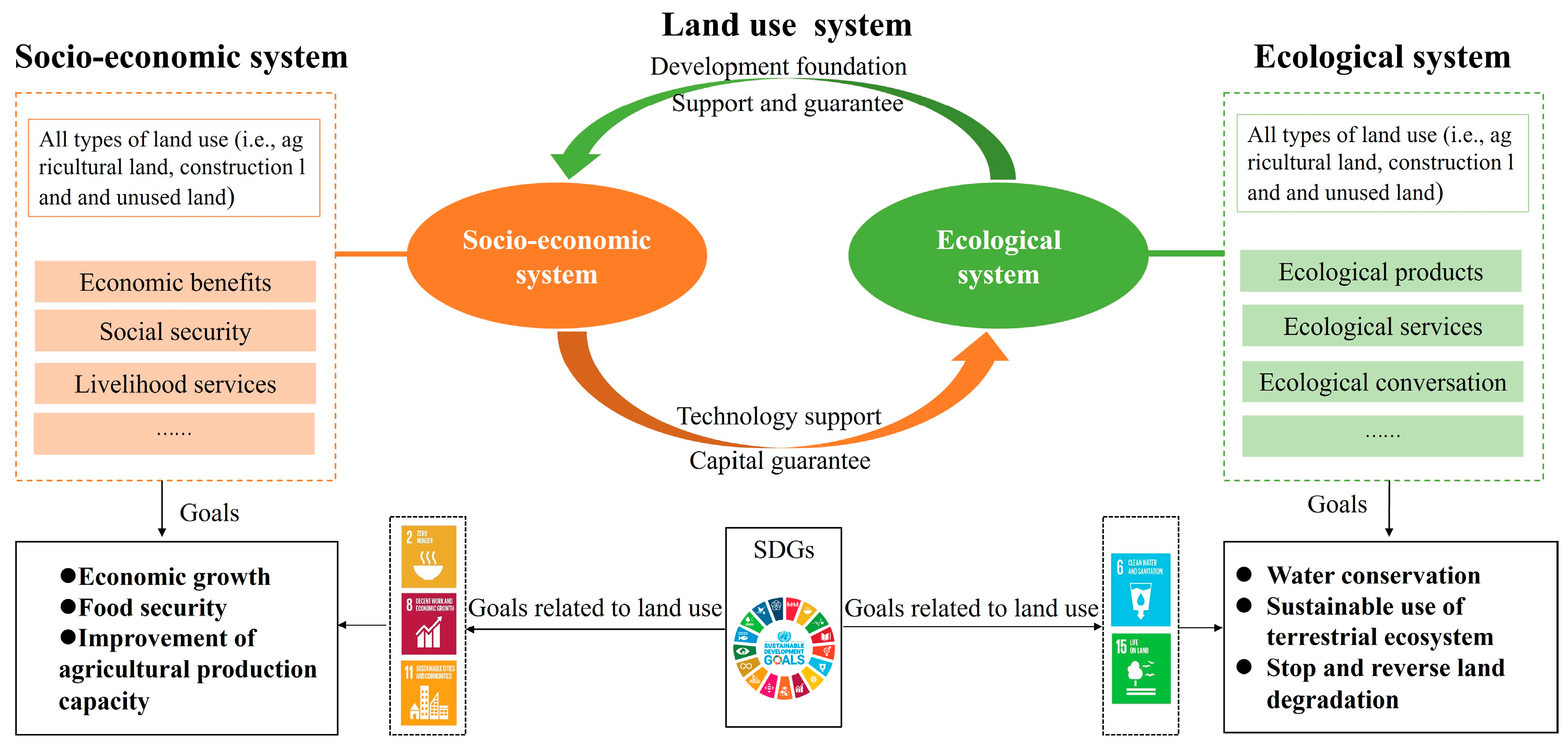

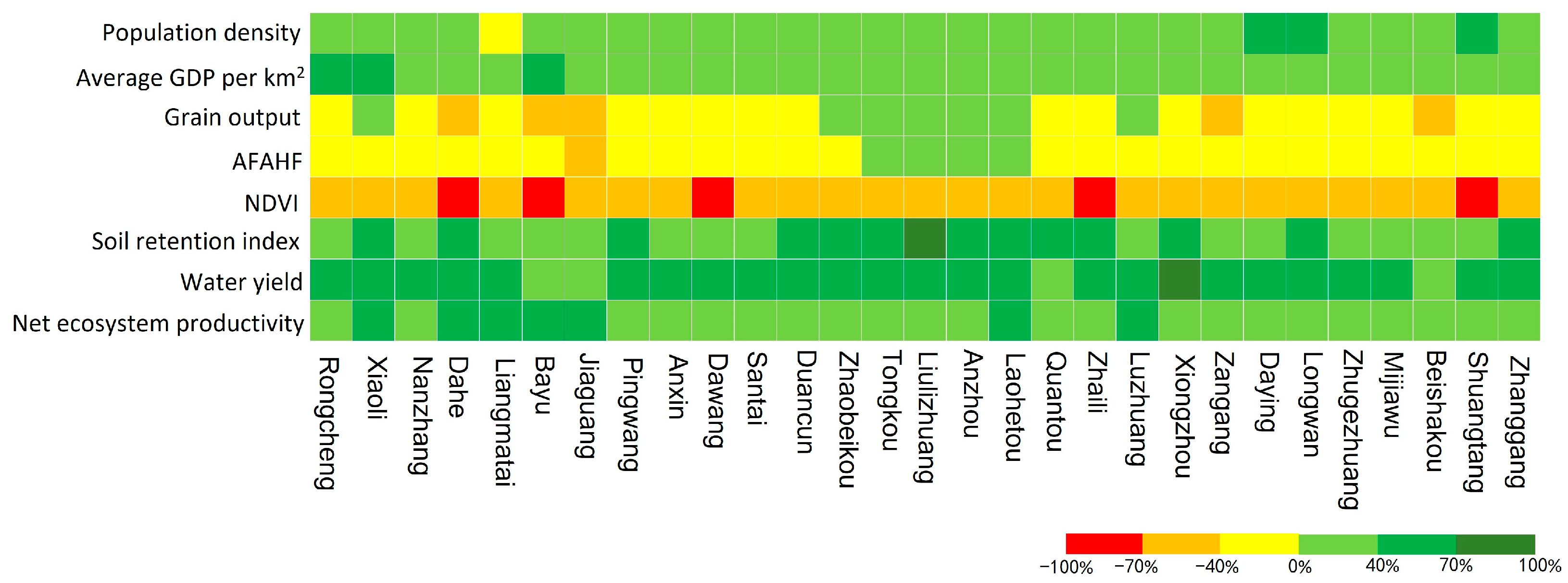
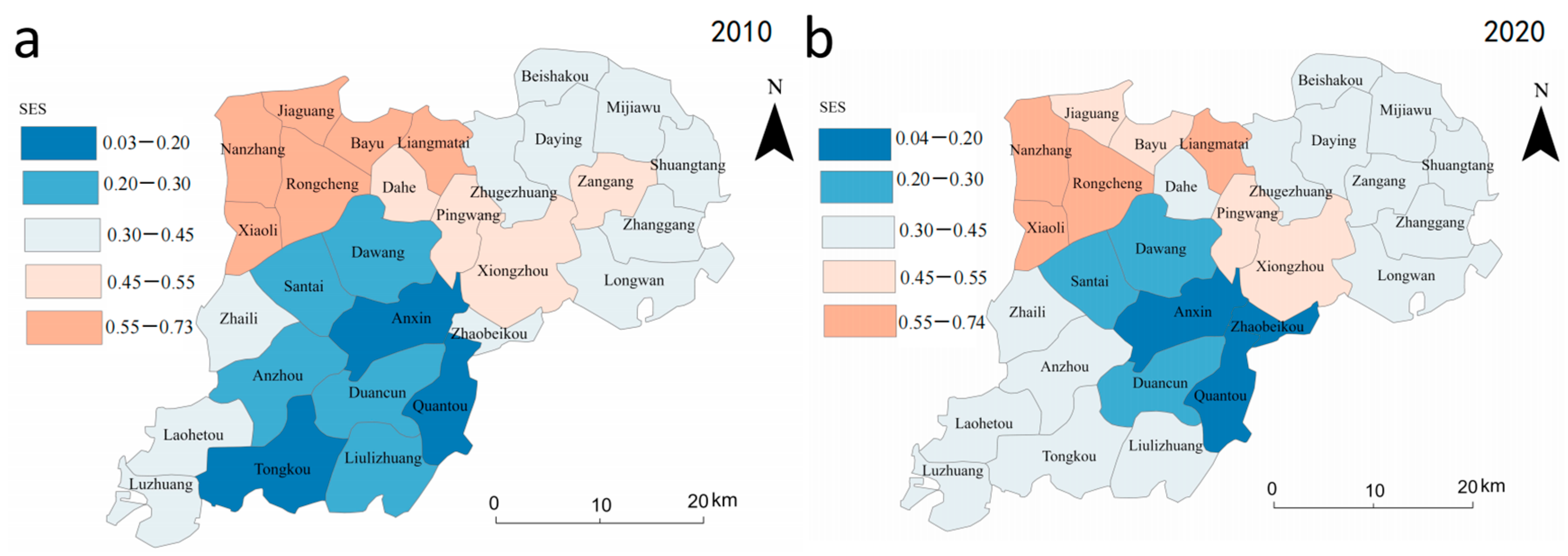

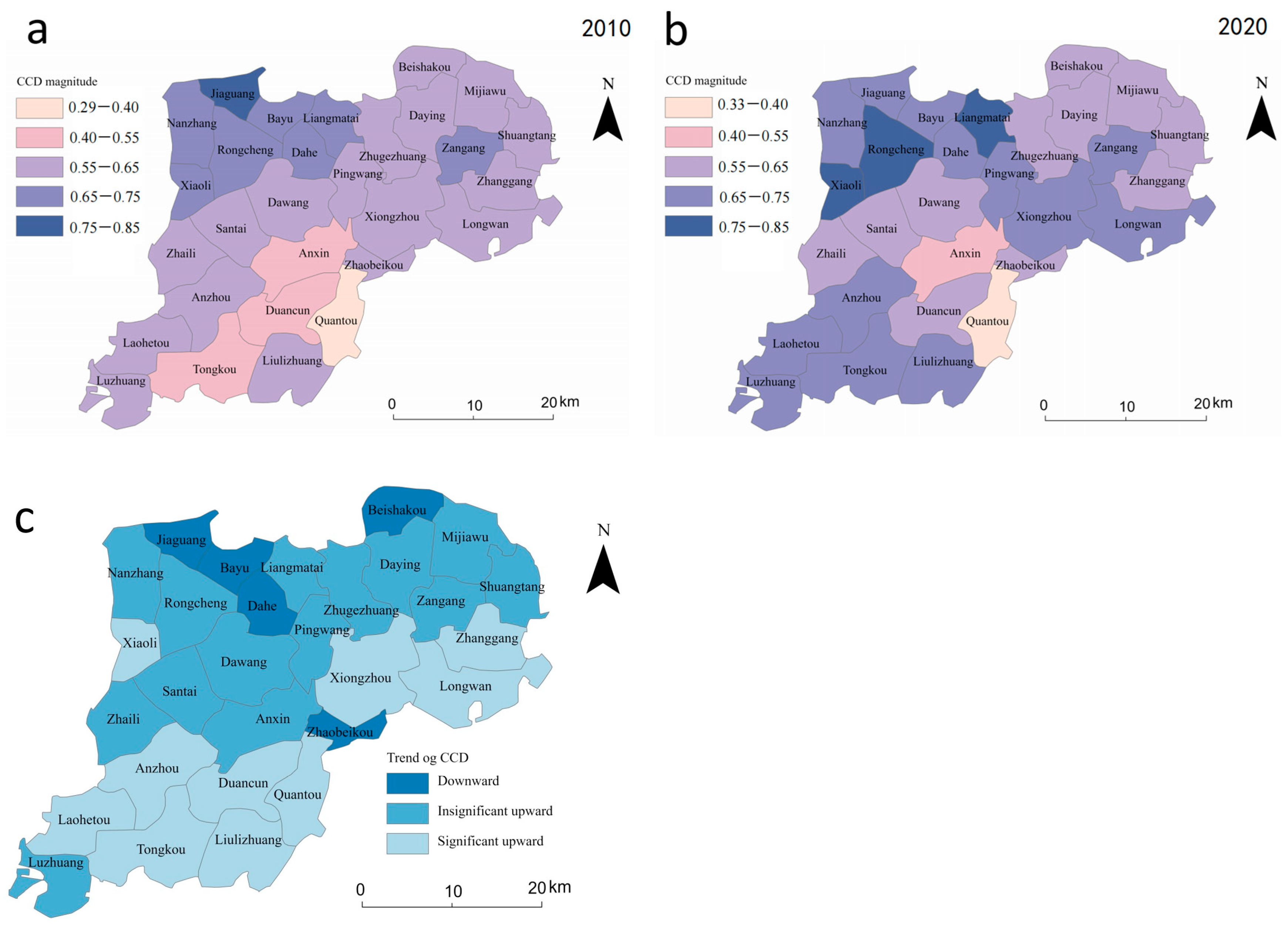

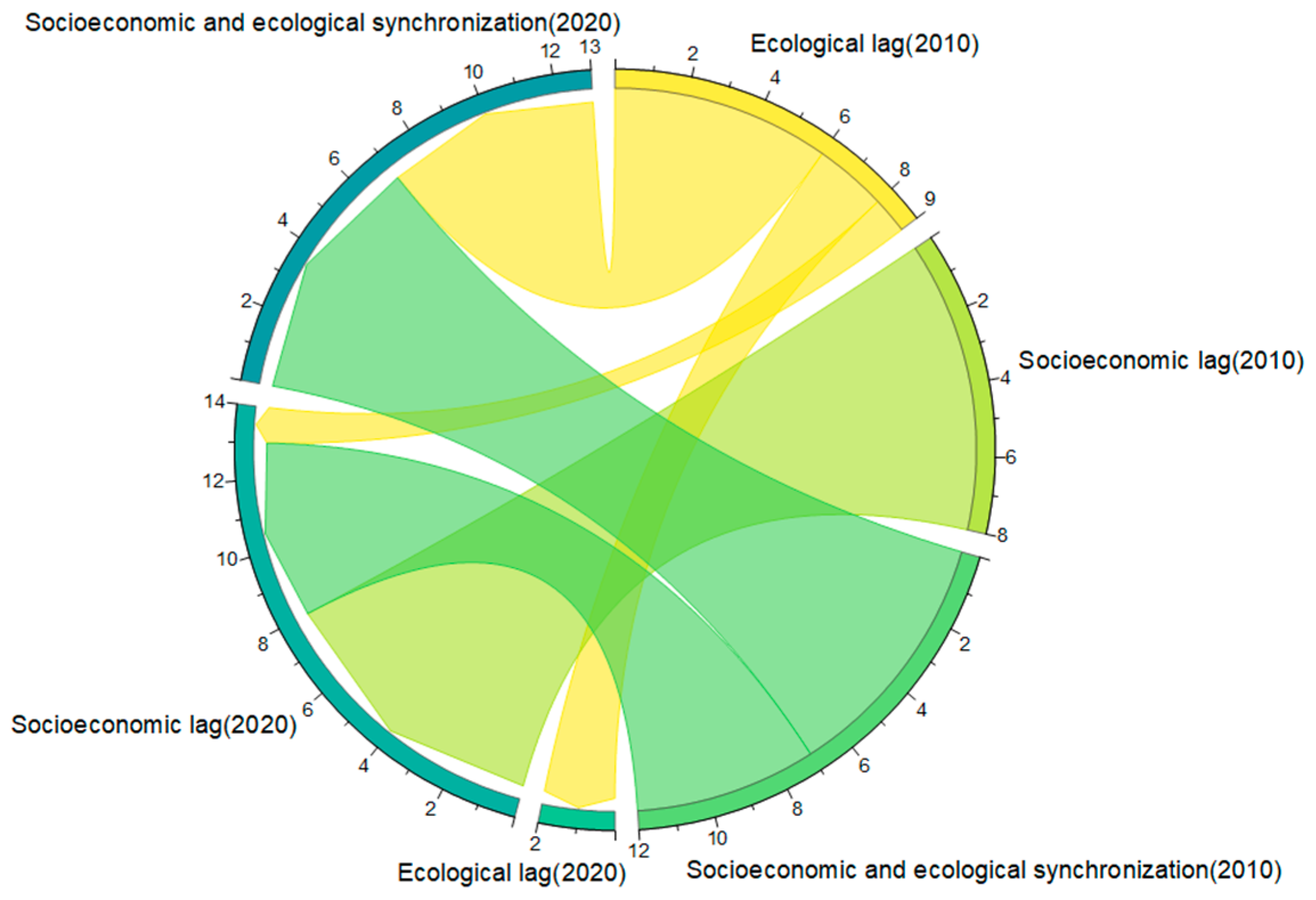

| Goals Corresponding to SDGs | Targets (A) | Indicators (B) | Unit | Corresponding Land Use Types | Property | Weight |
|---|---|---|---|---|---|---|
| Goal 11 Social security | Socioeconomic sustainability (A1) | Population density (B1) | Capita/km2 | All types of land use | + | 0.169 |
| Goal 1 No poverty | Average GDP per km2 (B2) | 10,000 RMB/km2 | + | 0.289 | ||
| Goal 2 Zero hungry | Grain output (B3) | Kg/km2 | Cultivated land | + | 0.253 | |
| Goal 8 Decent work and economic growth | Output of AFAHF (B4) | 10,000 RMB/km2 | Agricultural land | + | 0.289 | |
| Goal 15 Life on land | Ecological sustainability (A2) | NDVI (B5) | # | All types of land use | + | 0.281 |
| Soil retention (B6) | t/m2 | + | 0.342 | |||
| Goal 6 Water conservation | Water yield (B7) | mm/m2 | + | 0.273 | ||
| Goal 15 Life on land | NEP (B8) | g C/m2/yr | + | 0.103 |
| Category | Level | Subcategory | Function | Type |
|---|---|---|---|---|
| Uncoordinated development | 0.0 < D ≤ 0.4 | serious incoordination | ES < SES | Ecological lag |
| ES > SES | Socioeconomic lag | |||
| ES = SES | Socioeconomic and ecological synchronization | |||
| 0.4 < D ≤ 0.55 | moderate incoordination | ES < SES | Ecological lag | |
| ES > SES | Socioeconomic lag | |||
| ES = SES | Socioeconomic and ecological synchronization | |||
| Transformative development | 0.55 < D ≤ 0.65 | primary coordination | ES < SES | Ecological lag |
| ES > SES | Socioeconomic lag | |||
| ES = SES | Socioeconomic and ecological synchronization | |||
| 0.65 < D ≤ 0.75 | moderate coordination | ES < SES | Ecological lag | |
| ES > SES | Socioeconomic lag | |||
| ES = SES | Socioeconomic and ecological synchronization | |||
| 0.75 < D ≤ 0.85 | higher coordination | ES < SES | Ecological lag | |
| ES > SES | Socioeconomic lag | |||
| ES = SES | Socioeconomic and ecological synchronization | |||
| Coordinated development | 0.85 < D ≤ 1 | optimal coordination | ES < SES | Ecological lag |
| ES > SES | Socioeconomic lag | |||
| ES = SES | Socioeconomic and ecological synchronization |
| 2010 | 2020 | |||||
|---|---|---|---|---|---|---|
| Cropland | Forest | Grassland | Water | Impervious | Sum | |
| Cropland | 1151.52 | 2.42 | 0.00 | 29.11 | 67.84 | 1250.89 |
| Forest | 0.22 | 0.85 | 0.00 | 0.13 | 0.01 | 1.21 |
| Grassland | 0.00 | 0.00 | 0.00 | 0.00 | 0.02 | 0.02 |
| Water | 2.39 | 0.19 | 0.00 | 23.89 | 0.42 | 26.89 |
| Impervious | 8.14 | 0.01 | 0.00 | 1.16 | 269.07 | 278.38 |
| Sum | 1162.27 | 3.47 | 0.00 | 54.29 | 337.36 | 1557.39 |
| Year | 2010 | 2020 |
|---|---|---|
| Number of units | 29 | |
| Serious incoordination (%) | 3.45 | 3.45 |
| Moderate incoordination(%) | 6.90 | 3.45 |
| Primary coordination(%) | 62.07 | 37.93 |
| Moderate coordination(%) | 24.14 | 44.83 |
| Higher coordination(%) | 3.45 | 10.34 |
| Max | 0.76 | 0.82 |
| Min | 0.30 | 0.34 |
| Mean | 0.61 | 0.65 |
| 2020 | ||||||
|---|---|---|---|---|---|---|
| Year 2010 | Serious Incoordination | Moderate Incoordination | Primary Coordination | Moderate Coordination | Higher Coordination | Sum |
| Serious incoordination | 3.45 (1) | 0.00 (0) | 0.00 (0) | 0.00 (0) | 0.00 (0) | 3.45 (1) |
| Moderate incoordination | 0.00 (0) | 3.45 (1) | 0.00 (0) | 3.45 (1) | 0.00 (0) | 6.90 (2) |
| Primary coordination | 0.00 (0) | 0.00 (0) | 37.93 (11) | 24.14 (7) | 0.00 (0) | 62.07 (18) |
| Moderate coordination | 0.00 (0) | 0.00 (0) | 0.00 (0) | 13.79 (4) | 10.34 (3) | 24.14 (7) |
| Higher coordination | 0.00 (0) | 0.00 (0) | 0.00 (0) | 3.45 (1) | 0.00 (0) | 3.45 (1) |
| Sum | 3.45 (1) | 3.45 (1) | 37.93 (11) | 44.83 (13) | 10.34 (3) | 100.00 (29) |
| Year 2010 | 2020 | |||
|---|---|---|---|---|
| Ecological Lag | Socioeconomic Lag | Socioeconomic and Ecological Synchronization | Sum | |
| Ecological lag | 6.90 (2) | 3.45 (1) | 20.69 (6) | 31.03 (9) |
| Socioeconomic lag | 0.00 (0) | 27.59 (8) | 0.00 (0) | 27.59 (8) |
| Socioeconomic and ecological synchronization | 0.00 (0) | 17.24 (5) | 24.14 (7) | 41.38 (12) |
| Sum | 6.90 (2) | 48.28 (14) | 55.17 (16) | 100.00 (29) |
| Year | Factors | Population Density (B1) | Average GDP per km2 (B2) | Grain Output (B3) | Output of AFAHF (B4) | Normalized Difference Vegetation Index (B5) | Soil Retention (B6) | Water Yield (B7) | NEP (B8) |
|---|---|---|---|---|---|---|---|---|---|
| 2010 | q | 0.649 | 0.581 | 0.725 | 0.536 | 0.240 | 0.141 | 0.764 | 0.490 |
| p-value | 0.000 | 0.000 | 0.000 | 0.326 | 0.116 | 0.927 | 0.000 | 0.012 | |
| 2020 | q | 0.603 | 0.565 | 0.410 | 0.571 | 0.208 | 0.385 | 0.562 | 0.534 |
| p-value | 0.000 | 0.000 | 0.759 | 0.000 | 0.250 | 0.096 | 0.007 | 0.000 |
Disclaimer/Publisher’s Note: The statements, opinions and data contained in all publications are solely those of the individual author(s) and contributor(s) and not of MDPI and/or the editor(s). MDPI and/or the editor(s) disclaim responsibility for any injury to people or property resulting from any ideas, methods, instructions or products referred to in the content. |
© 2024 by the authors. Licensee MDPI, Basel, Switzerland. This article is an open access article distributed under the terms and conditions of the Creative Commons Attribution (CC BY) license (https://creativecommons.org/licenses/by/4.0/).
Share and Cite
Wang, X.; Zhao, H.; Qian, J.; Li, X.; Cao, C.; Feng, Z.; Cui, Y. Sustainable Land Use Diagnosis Based on the Perspective of Coupling Socioeconomy and Ecology in the Xiongan New Area, China. Land 2024, 13, 92. https://doi.org/10.3390/land13010092
Wang X, Zhao H, Qian J, Li X, Cao C, Feng Z, Cui Y. Sustainable Land Use Diagnosis Based on the Perspective of Coupling Socioeconomy and Ecology in the Xiongan New Area, China. Land. 2024; 13(1):92. https://doi.org/10.3390/land13010092
Chicago/Turabian StyleWang, Xiaoxiao, Huafu Zhao, Jiacheng Qian, Xiao Li, Congjie Cao, Zhe Feng, and Yiqing Cui. 2024. "Sustainable Land Use Diagnosis Based on the Perspective of Coupling Socioeconomy and Ecology in the Xiongan New Area, China" Land 13, no. 1: 92. https://doi.org/10.3390/land13010092
APA StyleWang, X., Zhao, H., Qian, J., Li, X., Cao, C., Feng, Z., & Cui, Y. (2024). Sustainable Land Use Diagnosis Based on the Perspective of Coupling Socioeconomy and Ecology in the Xiongan New Area, China. Land, 13(1), 92. https://doi.org/10.3390/land13010092








